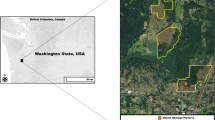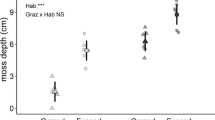Summary
The turf structure of terrestrial mosses was analysed in the understory of white spruce associations along two SO2 stress gradients associated with a single SO2 source. Changes in coverage, turf depth, biomass and percent living moss were followed. SO2 stress initially caused changes in turf structure in the vertical plane (green turf depth, percentage and biomass) whereas changes in the horizontal plane (coverage) were most noticeable in areas of severe stress. The Index of Atmospheric Purity (IAP) reflected SO2 stress only in these latter areas. Intrusion of weeds and increased prominence of subordinate species occurred in lightly stressed areas, but these perturbations were not reflected by the IAP. The effect of Q i, frequency, and coverage factors in the IAP are discussed and the criteria of the Index of Community Vigor are proposed.
Similar content being viewed by others
References
Barkman, J.I.: The influence of air pollution on bryophytes and lichens. In: Air pollution. Proceedings of the first European Congress on the influence of air pollution on plants and animals, Wageningen 1968. Wageningen: Centre for Agricultural Publishing and Documentation 1969
Benson-Evans, K.: Physiology of the reproduction of bryophytes. Bryol. 67, 431–445 (1964)
Brodo, I.M.: Lichen growth and cities: A study on Long Island, New York, Bryol. 69, 427–449 (1967)
Coker, P.D.: The effects of sulphur dioxide pollution on bark epiphytes. Trans. Br. Bryol. Soc. 5, 341–347 (1967)
Daubenmire, R.: A canopy-coverage method of vegetational analysis. Northw. Sci. 33, 43–64 (1959)
Daubenmire, R.: Plant communities: A textbook of plant synecology. New York: Harper and Row 1968
DeSloover, J.R.: Végétaux epiphytes et pollution de l'air. Reoue Quat. Scient. 25, 531–561 (1964) [cited by Hawksworth (1973)]
Gilbert, O.L.: Lichens as indicators of air pollution in the Tyne Valley. In: Ecology and the industrial society (G.T. Goodman, R.W. Edwards, J.M. Lambert, eds.). Oxford: Blackwell 1965
Gilbert, O.L.: Bryophytes as indicators of pollution in the Tyne Valley. New Phytol. 67, 15–30 (1968)
Gilbert, O.L.: Further studies on the effect of sulphur dioxide on lichens and bryophytes. New Phytol. 69, 605–627 (1970)
Gilbert, O.L.: A biological scale for the estimation of sulphur dioxide pollution. New Phytol. 69, 629–634 (1970)
Hawksworth, D.L.: Mapping studies. In: Air pollution and lichens (B.W. Ferry, M.S. Baddeley, D.L. Hawksworth, eds.). London: Athlone Press at Univ. of London 1973
Hoffman, G.R.: The influence of a paper pulp mill on the ecological distribution of epiphytic cryptogams in the vicinity of Lewiston, Idaho and Clarkston, Washington. Environ. Pollut. 7, 283–301 (1974)
LeBlanc, F., DeSloover, J.: Relation between industrialization and the distribution and growth of epiphytic lichens and mosses in Montreal. Can. J. Bot. 48, 1485–1496, (1970)
LeBlanc, F., Rao, D.N.: Evaluation of the pollution and drought hypothesis in relation to lichens and bryophytes in urban environments. Bryol. 76, 1–19 (1973)
Longton, R.E., Greene, S.W.: Relationship between sex distribution and sporophyte production in Pleurozium schreberi (Brid.). Mitt. Ann. Bot. 33, 107–126 (1969)
Nash, E.H.: The effects of effluents from a zinc smelter on mosses. Ph. D. thesis, Rutgers St. University (1970)
Nash, T.H., III, Nash, E.H.: Sensitivity of mosses to SO2. Oecologia (Berl.) 17, 257–263 (1974)
Rao, D.N., LeBlanc, F.: Influence of an iron-sintering plant on corticolous epiphytes in Wawa, Ontario. Bryol. 70, 141–157 (1967)
Skye, E.: Lichens and air pollution. Acta Phytogeogr. Suec. 52, 1–123 (1968)
Stringer, P.W., Stringer, M.H.L.: A quantitative study of corticolous bryophytes in the vicinity of Winnipeg, Manitoba. Bryol. 77, 551–560 (1974)
Taoda, H.: Mapping of atmospheric pollution in Tokyo based upon epiphytic bryophytes. Jap. J. Ecol. 22, 125–133 (1972)
Taoda, H.: Bryophytes as indicators of air pollution. In: Science for better environment. Proceedings of the International Congress on the human environment (Secretar. HESC Organizing Committee, Sci. Counc. of Japan, ed.). Tokyo: The Asahi Evening News 1976
Winner, W.E., Bewley, J.D.: Contrasts between bryophyte and vascular plant synecologia responses in an SO2-stressed white spruce association in Central Alberta. Oecologia (Berl.) 33, 311–325 (1978)
Winner, W.E., Bewley, J.D., Krouse, H.R.: Variations in coverage, diversity, and sulfur isotopes in mosses along two SO2-stress gradients in white spruce stands near Fox Creek, Alberta. In: Proceedings of the Alberta Sulfur Gas Workshop III. Alberta Environment Research Secretariat, Edmonton, Alta. (1977)
Wood, C.W., Jr., Nash, T.H., III.: Copper smelter effluent effects on Sonoran desert vegetation. Ecology 57, 1311–1316 (1976)
Author information
Authors and Affiliations
Rights and permissions
About this article
Cite this article
Winner, W.E., Bewley, J.D. Terrestrial mosses as bioindicators of SO2 pollution stress. Oecologia 35, 221–230 (1978). https://doi.org/10.1007/BF00344733
Received:
Issue Date:
DOI: https://doi.org/10.1007/BF00344733




